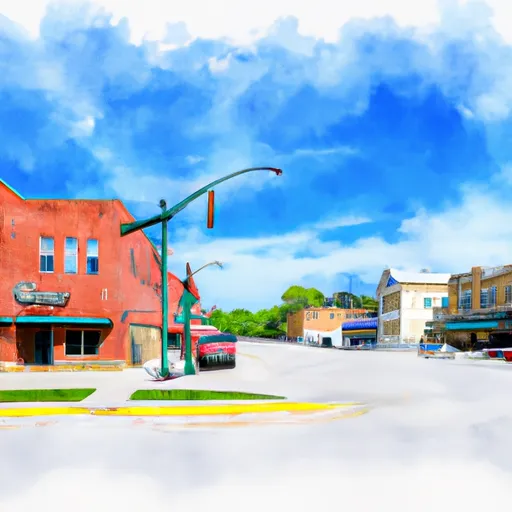-
 Snoflo Premium
Snoflo Premium
Get unlimited access to all our content
With no Ad interruptions! - Start Your Free Trial Login with existing account
Mendota
Eden Index
Climate
6.7
•
Recreation
5.3
•
Community
4.9
•
Safeguard
5.8/10

Mendota, Minnesota is a charming city located in Dakota County, situated on the banks of the picturesque Minnesota River. The climate in Mendota is classified as humid continental, characterized by cold winters and warm summers. Average temperatures range from highs of around 30°F (-1°C) in winter to mid-80s°F (29°C) in summer. Snowfall is common during the winter months, providing opportunities for winter sports enthusiasts.
The city's location along the Minnesota River offers various hydrology constituents. The river serves as a vital water resource, supporting diverse wildlife and vegetation. Boating and fishing are popular activities, with anglers seeking walleye, bass, and catfish. The extensive riverfront trails provide opportunities for scenic walks, biking, and birdwatching.
Mendota is surrounded by several parks that offer outdoor recreation opportunities. At Fort Snelling State Park, visitors can explore trails, go camping, and enjoy panoramic river views. Pike Island, located at the confluence of the Minnesota and Mississippi rivers, offers picturesque hiking trails. Additionally, Mendota is home to the Sibley Historic Site, which preserves the heritage and history of the area. With its natural beauty and recreational offerings, Mendota is a delightful destination for outdoor enthusiasts and nature lovers.
What is the Eden Index?
The Snoflo Eden Index serves as a comprehensive rating system for regions, evaluating their desirability through a holistic assessment of climate health, outdoor recreation opportunities, and natural disaster risk, acknowledging the profound impact of these factors on livability and well-being.
Climate Health Indicator (CHI): 6.7
Mendota receives approximately
797mm of rain per year,
with humidity levels near 83%
and air temperatures averaging around
8°C.
Mendota has a plant hardyness factor of
4, meaning
plants and agriculture in this region thrive during a short period during spring and early summer. Most
plants will die off during the colder winter months.
By considering the ideal temperature range, reliable water supplies, clean air, and stable seasonal rain or snowpacks, the Climate Health Indicator (CHI) underscores the significance of a healthy climate as the foundation for quality living.
A healthy climate is paramount for ensuring a high quality of life and livability in a region, fostering both physical well-being and environmental harmony. This can be characterized by ideal temperatures, reliable access to water supplies, clean air, and consistent seasonal rain or snowpacks.
Weather Forecast
Streamflow Conditions
Minnesota
Area Rivers
Minnesota
Snowpack Depths
Minnesota
Reservoir Storage Capacity
Minnesota
Groundwater Levels
Recreational Opportunity Index (ROI): 5.3
The Recreational Opportunity Index (ROI) recognizes the value of outdoor recreational options, such as parks, hiking trails, camping sites, and fishing spots, while acknowledging that climate plays a pivotal role in ensuring the comfort and consistency of these experiences.
Access to outdoor recreational opportunities, encompassing activities such as parks, hiking, camping, and fishing, is crucial for overall well-being, and the climate plays a pivotal role in enabling and enhancing these experiences, ensuring that individuals can engage in nature-based activities comfortably and consistently.
Camping Areas
| Campground | Campsites | Reservations | Toilets | Showers | Elevation |
|---|---|---|---|---|---|
| McCarthy Beach State Park | 90 | 1,393 ft | |||
| Button Box ? George Washington State Forest | 12 | 1,400 ft | |||
| Wallashuck - Red Rock Lake | 80 | 833 ft | |||
| North Overlook - Red Rock Lake | 55 | 796 ft | |||
| Elk Rock State Park | 75 | 843 ft | |||
| Roberts Creek Park | None | 803 ft | |||
| Howell Station - Red Rock Lake | 140 | 704 ft | |||
| Ivans - Red Rock Lake | None | 708 ft | |||
| Whitebreast - Red Rock Lake | 130 | 828 ft | |||
| Woodenfrog - Kabetogama State Forest | 60 | 1,126 ft |
Nearby Ski Areas
Catastrophe Safeguard Index (CSI):
The Catastrophe Safeguard Index (CSI) recognizes that natural disaster risk, encompassing floods, fires, hurricanes, and tornadoes, can drastically affect safety and the overall appeal of an area.
The level of natural disaster risk in a region significantly affects safety and the overall livability, with climate change amplifying these risks by potentially increasing the frequency and intensity of events like floods, fires, hurricanes, and tornadoes, thereby posing substantial challenges to community resilience and well-being.
Community Resilience Indicator (CRI): 4.9
The Community Resilience Indicator (CRI) recognizes that education, healthcare, and socioeconomics are crucial to the well-being of a region. The CRI acknowledges the profound impact of these elements on residents' overall quality of life. By evaluating educational resources, healthcare accessibility, and economic inclusivity, the index captures the essential aspects that contribute to a thriving community, fostering resident satisfaction, equity, and social cohesion.

